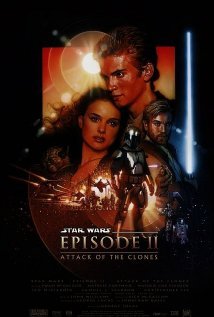“A Bitter Heart Threatens the Kingdom”

| None | Light | Moderate | Heavy | |
|---|---|---|---|---|
| Language | ||||
| Violence | ||||
| Sex | ||||
| Nudity |
What You Need To Know:
Teenagers will love the space-races and action scenes in STAR WARS II, especially during the dynamic second half, and adults will marvel at the colorful sights. The movie is beautifully made, heavy on special effects and filled with some good moral truths. George Lucas has diluted the moral elements of the first movie, however, strengthened the pagan qualities in the movie’s spiritual worldview and added a boring first half with weak acting and bad scriptwriting, especially in the scenes featuring Hayden Christensen as Anakin and Natalie Portman as Padme. Proceed with caution, therefore, especially where children and young teenagers are concerned.
Content:
(PaPa, O, BB, C, I, L, VVV, A, D, M) Undeveloped, but consistent, pagan (almost Buddhist, somewhat New Agey) worldview where heroes are taught to engage with the apparently impersonal, transcendent spiritual “force” in the universe in an illogical, impersonal way; occult elements include mind control, telekinesis and mild references to telling the future; solid moral elements and minor redemptive elements include epic battle between good and evil where good is preferred, strong (almost conservative) warnings about the dangers of a totalitarian dictatorship, many references to the proper maturing and training process of trusted kingdom warriors, references to the necessity of unity to prevail against the enemy, and the fruits of bitterness and the susceptibility of the heart to evil when unforgiveness remains; some internationalist elements with a Council resembling the United Nations; some politically correct elements regarding smoking, campaign contributions and “democracy”; very light foul language includes one “damn,” one reference to “poo-doo” and some light name-calling; strong violence includes numerous light saber fights resulting in limbs frequently flying, a child seeing his father’s head chopped off, a tortured mother dying in character’s arms, scary killer centipedes inserted into bedroom at night, & many battle scenes with humans, monsters, aliens, and robots; no sex or nudity; alcohol use depicted with several bar scenes; smoking depicted but strongly condemned (“You want to sell me a death stick?”); and, morally conflicted protagonist disobeys orders (sometimes to help other people, but sometimes in a reckless, rebellious manner) and protagonist reveals sympathy for dictator-style leadership, saying, “Someone wise . . . should make everyone agree to do what’s best for all the people,” a thought that one character explicitly rebukes and rest of movie implicitly rebukes.
More Detail:
Soon Jedi Knight Obi-Wan Kenobi (played Ewan McGregor) and his Padawan (knight-in-training) Anakin Skywalker (played by newcomer Hayden Christensen) are called in to protect Padme and discover the identity of her assassin. Meanwhile, a rogue Jedi named Count Dooku leads the separatists to rebel against the Senate. The Supreme Chancellor of the Senate, Senator Palpatine, moves for a vote of emergency powers so he can establish a large army to protect the Republic, which has not had a full-scale war for a thousand years.
As Obi-Wan’s investigations lead him to an intentionally elusive planet called Kamino, he finds a 200,000-member clone army being produced, with a bounty hunter named Jango Fett as the master clone. During a pulse-pounding intergalactic chase, Jango leads Obi Wan to Geonosis, where he meets Count Dooku and finds out a disturbing revelation about the former Jedi.
Left behind to protect Padme, Anakin’s childhood feelings for her continue to progress from friendship to romance. Understanding the crucial nature of each of their very different callings, however, the two leaders are conflicted in their willingness to let themselves become romantically attached. A Jedi Knight is supposed to withdraw from personal attachments, and Padme has her role as Senator to fulfill. When a tragedy threatens Anakin’s mother, Anakin pairs up with Padme as a warrior, instead of a love interest.
After some shocking and disturbing finds, deep bitterness of heart soon threatens both the love relationship between Anakin and Padme . . . AND the kingdom as a whole. A strategic battle must be fought where odds are against the good guys and clear-headed, unified decisions must be made with split-second precision. Some crucial questions remain: Will the important and beloved senator live, or will her own decision to endanger her life spoil the protection once afforded her? Does young Anakin possess the stuff of a true and loyal Jedi warrior, or will his rash actions, immaturity and personal wounds overshadow his good judgment? Are the clones truly fighting for the Republic, or might there be some mixed alliances foreshadowed? Will there be enough Jedi power to resist the growing enemy coalition with its mixed bag of compromisers? Will the Republic survive such a Civil War?
ATTACK OF THE CLONES has most of the fun elements true STAR WARS fans look for, especially in the movie’s more exciting, more dynamic second half. There are incredible fight scenes, fast and fun spacecrafts swirling about, clever intergalactic battles, and every special effect in the book. In typical George Lucas style, this movie brings us numerous imaginative new creatures, several futuristic bar scenes and incredibly detailed and realistic backgrounds for every scene – all with the help of computer-generated images. Teenage boys will love the fight scenes, battle sequences and space races in the spaceships that look like sports cars, and adults will marvel at the cities in the sky, which look a lot like Times Square on steroids. The costuming and audio effects are unbeatable.
Regrettably, the first half of this movie is not very convincing. A couple of the stunts during the movie’s first chase scene, for instance, are unbelievable, much like the early scenes in the worst of the Indiana Jones movies that George Lucas did, INDIANA JONES AND THE TEMPLE OF DOOM. The acting by Hayden Christensen as Anakin/Darth Vader and Natalie Portman as Padme and the scripting of their characters’ dialogue is also unbelievable and poorly done. This second item is, perhaps, the movie’s fatal flaw and doesn’t bode well for STAR WARS III. It doesn’t help, however, that the story in the first half of the movie is weak in that it consists mainly of Anakin and Obi-wan Kenobi protecting Padme’s life and tracking down two mysterious villains, who don’t really engage the audience until much later, if at all. Heroic actions like the kind on which the STAR WARS movies thrive require a definite villain and a positive goal of some kind. Eventually, this does happen when Obi-wan meets up with the bounty hunter behind the assassination attempts on Padme and when the movie introduces Count Dooku, the man behind the separatist movement. The movie’s climactic battle scenes are, collectively speaking, among the best that have ever been done.
Despite the weak acting by Christensen and Portman, Ewan McGregor is great as Obi-wan Kenobi. The first part of the movie should have concentrated more on Obi-wan and Anakin working together to defeat the villains; the petulant attitude from Anakin during much of the movie’s first half was continually grating, with not much explanation on why Anakin was being so surly so much of the time. Once the story kicks into overdrive, this problem mostly vanishes.
Also wonderful is Christopher Lee as Count Dooku. Lee does a marvelous job of being earnestly menacing and cryptic at the same time. Viewers won’t know until the ending just which side Dooku is really supporting. As for Samuel L. Jackson, viewers may want to see more of his character, who seems to show only two emotions – quiet pensiveness or slightly angry. Lucas needs to give this character much more depth.
Finally, the movie would not be half as fun were it not for the very funny events and dialogue that happen when C3PO, the talkative droid, gets involved in the action at the end of the movie. Much credit should go to Anthony Daniels’ marvelous delivery of some really humorous lines.
Some of the spiritual parallels in STAR WARS II are also wonderful. Obi-Wan tells Anakin, “Be mindful of your thoughts. Don’t focus on the dark side.” This comment undercuts the regrettable, Romantic elements in the first trilogy, because it shows that emotions are something that Anakin must be “mindful” of, as Obi-wan is wont to say. At another point, a friend reminds Obi-Wan, “Jedis should know the difference between knowledge and wisdom.” One of the villains tells Anakin something like, “Trust your feelings . . . eventually you’ll become more powerful than the highest of Jedis.”
Though conflicted at times, Anakin also comes out with some real wisdom. He tells Padme, “Jedis are to have no attachments or possessions, but compassion and unconditional love are essential for a warrior’s life. We are encouraged to love.” Padme encourages decisions to be made by first following each thought to its logical and pragmatic conclusion. If the decision is not good, the decision is not a wise one.
Anakin often speaks like a teenager as he says, “I’m ready for life’s trials. . . . Obi-Wan is over-critical of me! He just doesn’t understand!” Padme answers him, “Mentors have a way of seeing more of our faults than we like. It’s how we grow up.” Later, Anakin states, “I will be the most powerful Jedi ever!” Regrettably, his motivation stems from bitterness and anger, and some of his subsequent actions prove to be disastrous. This is the point of the story, however, which is supposed to describe why Anakin becomes Darth Vader and why Obi-wan Kenobi becomes Anakin’s sworn enemy.
STAR WARS II continues the first episode’s appropriate warnings about the corruption of power and the dangers of creating a totalitarian dictatorship. These warnings sometimes sound very conservative, if not biblical. This time, however, this positive element is diluted by brief, mild politically correct elements, including shallow references to “democracy” and a joke about campaign contributions.
Worst of all, however, STAR WARS II seems to have abandoned the positive, theistic orientation that the first episode seemed to be moving toward at times. Apparently, George Lucas has decided to slightly reinforce the Buddhist leanings of the saga, where the heroes (and villains) engage an impersonal, illogical, spiritual, and transcendent “Force” in a mystical, partially occult way. Happily, Lucas has decided to downplay these elements in favor of the saga’s epic, action-oriented struggle between good and evil, with evil represented by a corrupt Empire manipulated by corrupt villains who have sin in their hearts. The other negative elements are there, nevertheless. They, and the movie’s strong action violence, merit a caution for older children and young teenagers and make the movie unacceptable for younger children.


 - Content:
- Content: 





